Embroidery, a centuries-old artistic tradition, holds profound significance in Mexican culture, intertwining history, identity, and creative expression threads.
Rooted in pre-Columbian civilizations and influenced by the vibrant tapestry of indigenous traditions, Mexican embroidery transcends mere craftsmanship.
This intricate art form serves as a living connection to ancestral roots, allowing contemporary Mexicans to weave their present with the threads of the past.
Beyond its historical ties, embroidery in Mexico is a vibrant language of symbols, colors, and stories, echoing in religious ceremonies, daily life, and celebrations. This cherished cultural practice reflects Mexican identity’s rich heritage and dynamic evolution.
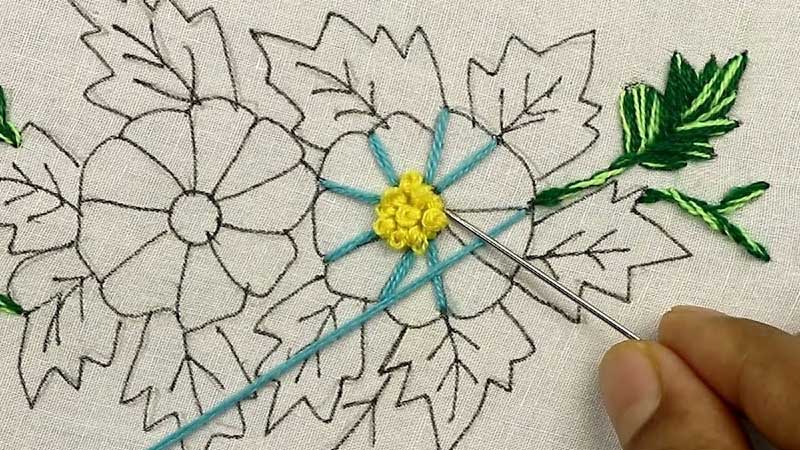
Why Is Embroidery Important in Mexican Cultures?
Embroidery holds significant cultural importance in Mexico for various reasons, reflecting the country’s rich history, diverse indigenous traditions, and the ongoing preservation of cultural identity.
Here are several reasons why embroidery is essential in Mexican culture:
Cultural Heritage and Tradition
Mexican embroidery has a long and storied history, dating back to pre-Columbian civilizations. Its continuity through generations serves as a link to the past, preserving traditional techniques and designs that embody the cultural heritage of indigenous communities.
Expressive Art Form
Embroidery serves as a powerful form of artistic expression in Mexico. Artisans use vibrant colors, intricate stitches, and diverse patterns to convey emotions, stories, and cultural motifs. Each piece of embroidered art is a unique representation of the creator’s creativity and vision.
Connection to Ancestral Roots
Engaging in embroidery allows contemporary Mexicans to connect with their ancestors.
By employing age-old techniques and creating designs passed down through generations, individuals maintain a tangible link to their cultural roots, fostering a sense of continuity and identity.
Symbolism and Cultural Representation
Mexican embroidery often features symbolic elements representing various aspects of the country’s culture and history.
Symbols can include representations of nature, religious iconography, and indigenous motifs, adding layers of meaning to the art and contributing to a broader cultural narrative.
Utilitarian and Decorative Integration
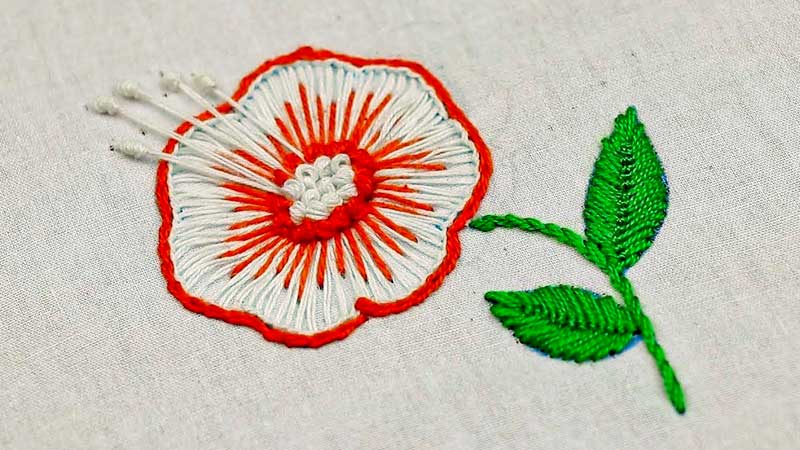
Embroidery is not confined to artistic pursuits; it seamlessly integrates into daily life. From clothing to household items, embroidery enhances objects’ utilitarian and decorative aspects, making it a ubiquitous presence in Mexican homes and communities.
Economic Importance
Many artisans in Mexico rely on embroidery as a source of income. The creation and sale of embroidered goods contribute to the economic well-being of individuals and communities. This financial aspect ensures the sustainability of the craft and its continuation across generations.
Religious and Ritual Significance
Embroidery is prominent in religious ceremonies, festivals, and significant life events. Garments adorned with intricate embroidery are often used in religious processions, adding a sense of reverence and ceremonial importance to the art form.
Adaptability and Evolution
While rooted in tradition, Mexican embroidery has shown adaptability to modern times. Artisans incorporate traditional designs and techniques into contemporary creations, ensuring the craft remains relevant and continues evolving.
Community and Social Bonds
The practice of embroidery often fosters a sense of community and social bonds. Embroidery brings people together through shared traditions, collaborative projects, or communal celebrations, reinforcing a collective cultural identity.
Historical Background of Mexican Embroidery
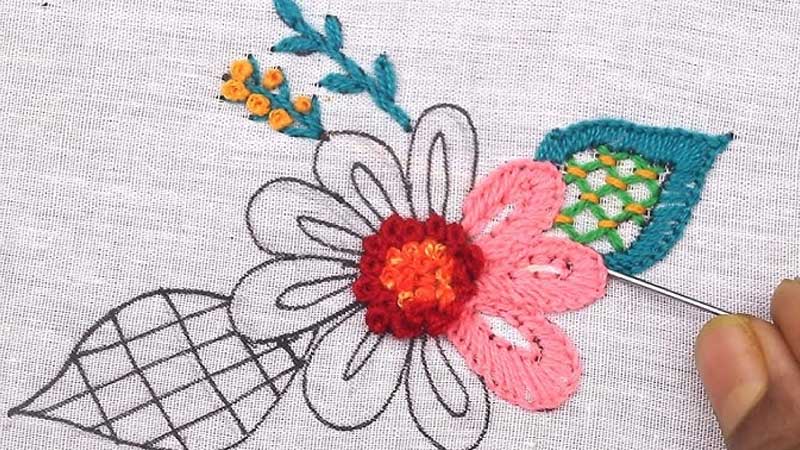
The history of Mexican embroidery is rich and diverse, reflecting a blend of indigenous, Spanish colonial, and later influences. The art of embroidery in Mexico has deep roots, dating back to pre-Columbian civilizations.
Here’s a brief historical background of Mexican embroidery:
Pre-Columbian Period
Embroidery in Mexico dates back to the pre-Columbian era when indigenous cultures like the Aztecs and Maya practiced intricate stitching with materials such as agave fibers and cotton.
Symbolic motifs on garments and textiles reflected connections to nature and religious beliefs.
Spanish Colonial Period
The Spanish conquest introduced new materials like silk and wool, blending European techniques with indigenous embroidery.
Ecclesiastical garments featured elaborate designs influenced by Catholic symbols, emphasizing the role of the Church in shaping Mexican embroidery.
19th Century
The 19th century saw embroidered works reflecting Mexico’s struggle for independence, incorporating patriotic symbols. Regional diversity in embroidery styles emerged, with each state developing distinct techniques and designs.
Mexican Revolution
The Mexican Revolution promoted indigenous identity and traditional arts as national pride and resistance symbols. Embroidery became a powerful expression of cultural identity during this transformative period.
Mid-20th Century to Present
A mid-20th-century revival focused on preserving and promoting traditional crafts, including embroidery. Organizations supported artisans, and Mexican embroidery gained international recognition for its vibrant colors, intricate designs, and cultural significance.
Modern Adaptations
Today, Mexican embroidery continues to evolve, adapting traditional designs to contemporary styles. Artisans experiment with new materials, contributing to the craft’s economic impact and sustainability.
This dynamic evolution reflects the enduring importance of Mexican embroidery in cultural identity and artistic expression.
What Are Some Popular Mexican Embroidery Styles?
Mexico has a rich embroidery tradition, and several popular styles are known for their vibrant colors, intricate designs, and cultural significance.
Here are some notable Mexican embroidery styles:
Otomi Embroidery (Tenango)
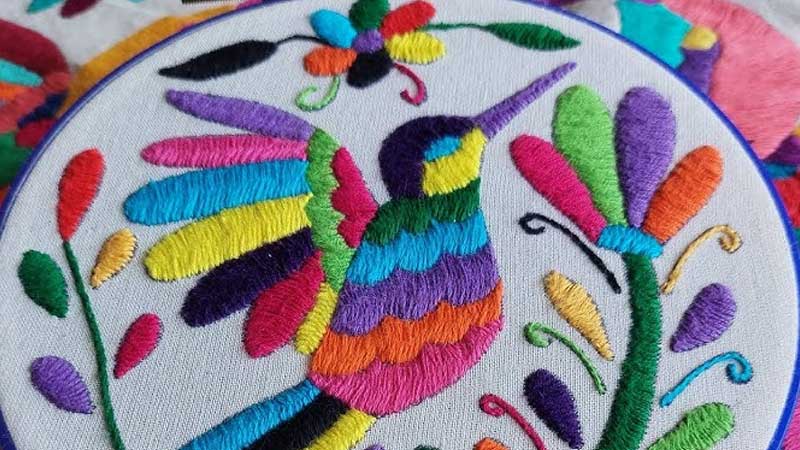
Originating from the Otomi people in the Hidalgo region, Tenango embroidery is characterized by colorful and whimsical designs featuring animals, plants, and mythological figures. The stitches are often small and intricate.
Zapotec Embroidery
Hailing from the Zapotec indigenous communities in Oaxaca, this style of embroidery often uses geometric patterns and motifs inspired by nature. The traditional Zapotec colors include red, black, and white.
Chiapas Embroidery
Chiapas, located in southern Mexico, is known for its diverse indigenous cultures, each contributing to unique embroidery styles. The designs often incorporate animals, flowers, and traditional symbols, with intricate stitchwork.
Puebla Embroidery (Puebla Dresses)
Puebla, particularly Tehuacán, is famous for its embroidered dresses, also known as “Tehuana” dresses. These garments feature colorful floral patterns, often stitched onto a white or pastel-colored fabric.
Mazahua Embroidery
The Mazahua people, who inhabit the State of Mexico and Michoacán, are known for their finely detailed embroidery work. Their designs often include flowers, animals, and scenes from daily life.
Yucatecan Embroidery
Hailing from the Yucatán Peninsula, this style often features bright and bold colors. Traditional Yucatecan dresses, known as “huipiles,” showcase intricate floral and geometric patterns.
Nahua Embroidery
The Nahua people, particularly those in the mountains of central Mexico, have a distinct embroidery style. Their designs often include images of daily life, birds, and flowers, with a preference for bold and contrasting colors.
Huatulco Embroidery
This style comes from the coastal region of Huatulco in Oaxaca. It often features marine-inspired designs, such as fish and shells, reflecting the influence of the ocean and local aquatic life.
How Has Mexican Embroidery Been Used in Traditional Mexican Clothing?
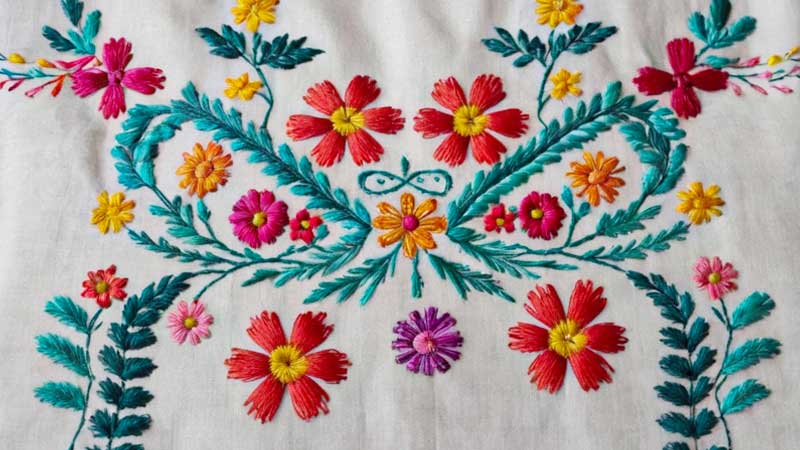
Mexican embroidery has played a significant role in traditional Mexican clothing, adding vibrant colors, intricate patterns, and cultural symbolism to various garments.
Here are some ways in which Mexican embroidery has been used in traditional clothing:
Huipiles
Huipiles are traditional Mexican blouses or tunics that come in various regional styles. They are often made from lightweight fabrics and adorned with elaborate embroidery.
Different regions have distinct huipil designs, with patterns representing local flora, fauna, and cultural symbols.
Tehuana Dresses
Tehuana dresses, originating from the Tehuantepec region in Oaxaca, are known for their opulent embroidery. These dresses typically feature floral and geometric patterns stitched onto a white or brightly colored fabric.
Tehuana dresses are often worn during special occasions and celebrations.
Embroidered Skirts (Enaguas)
Traditional Mexican skirts, or “enaguas,” can be intricately embroidered along the hemlines. These embroideries often showcase regional motifs and can vary in complexity and color depending on the specific cultural traditions of the area.
Rebozos
Rebozos are long, rectangular shawls that Mexican women drape over their shoulders. While not always fully embroidered, rebozos can feature intricate embroidery along the edges or incorporate embroidered panels into the design.
The embroidery adds a layer of beauty and craftsmanship to these versatile garments.
Children’s Clothing
Mexican embroidery, including dresses, blouses, and rompers, is frequently used in children’s clothing. These garments often feature playful and whimsical designs, making them visually appealing and culturally significant.
Wedding Attire
Traditional Mexican wedding attire often incorporates elaborate embroidery. Brides may wear intricately embroidered dresses, veils, and shawls, while grooms may have embroidered details on suits or traditional attire.
Accessories
Embroidery is not limited to clothing but to accessories like bags, belts, and hats. These items often showcase the artisanal skill of the embroiderer and can be both functional and decorative.
Regional Distinctions
Different regions in Mexico have their distinct embroidery styles, and traditional clothing reflects these regional variations.
Whether it’s the bold colors of Yucatecan embroidery or the intricate patterns of Tenango embroidery, the diversity of styles contributes to the richness of Mexican traditional clothing.
FAQs
Does embroidery play a role in modern Mexican life?
Yes, embroidery adapts to modern times, influencing fashion trends and remaining relevant in daily life, showcasing the dynamic evolution of the cultural practice.
What materials are commonly used in Mexican embroidery?
Traditional Mexican embroidery uses materials like cotton, wool, and silk threads. Additionally, artisans may incorporate beads, sequins, and other embellishments into their designs.
How has globalization impacted Mexican embroidery?
Globalization has provided new opportunities for Mexican embroidery by increasing its visibility and market reach. Artisans can now share their craft with a broader audience, leading to international recognition.
Can Mexican embroidery be considered a form of cultural diplomacy?
Yes, Mexican embroidery serves as a cultural ambassador, representing the country’s rich heritage globally and fostering a positive appreciation of Mexican culture beyond its borders.
To Recap
The importance of embroidery in Mexican culture resonates as a timeless tapestry, weaving together threads of heritage, artistic expression, and cultural continuity.
From its ancient origins, embroidery has been more than a craft; it is a bridge connecting generations, echoing the voices of ancestors, and narrating the collective story of a nation.
The vibrant stitches and intricate patterns not only adorn garments and textiles but also symbolize the resilience and pride of a people.
As embroidery adapts to modern times, its significance endures, reflecting Mexican culture’s diverse and dynamic spirit, ensuring that the art form remains an integral part of the country’s rich cultural tapestry.
Leave a Reply